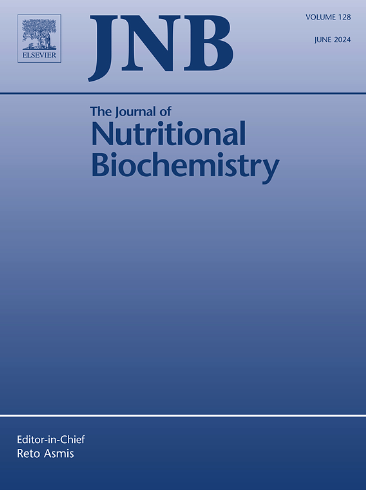限时喂食并不能防止适口食堂饮食对大鼠脂肪含量、认知能力和肠道微生物群的不良影响。
IF 4.8
2区 医学
Q1 BIOCHEMISTRY & MOLECULAR BIOLOGY
引用次数: 0
摘要
限时喂养(TRF)是一种流行的饮食策略,即把每天的食物摄入量限制在一定的范围内。本文章由计算机程序翻译,如有差异,请以英文原文为准。
Time-restricted feeding does not prevent adverse effects of palatable cafeteria diet on adiposity, cognition and gut microbiota in rats
Time-restricted feeding (TRF) is a popular dietary strategy whereby daily food intake is limited to a <12h window. As little is known about the effects of TRF on cognitive and behavioral measures, the present study examined the effects of time-restricted (8h/day; zeitgeber time [ZT]12–20) or continuous access to a high-fat, high-sugar cafeteria-style diet (Caf; Caf and Caf-TRF groups; n=12 adult male Sprague-Dawley rats) or standard chow (Chow and Chow-TRF groups) on short-term memory, anxiety-like behavior, adiposity and gut microbiota composition over 13-weeks with daily food intake measures. TRF significantly reduced daily energy intake in Caf- but not chow-fed groups. In Caf-fed groups, TRF reduced the proportion of energy derived from sugar while increasing that derived from protein. Caf diet significantly increased weight gain, adiposity and fasting glucose within 4 weeks; TRF partially reduced these effects. Caf diet increased anxiety-like behavior in the Elevated Plus Maze in week 3 but not week 12, and impaired hippocampal-dependent place recognition memory in week 11; neither measure was affected by TRF. Global microbiota composition differed markedly between chow and Caf groups, with a small effect of TRF in rats fed chow. In both chow and Caf diet groups, TRF reduced microbiota alpha diversity measures of Shannon diversity and evenness relative to continuous access. Results indicate only limited benefits of TRF access to an obesogenic diet under these conditions, suggesting that more severe time restriction may be required to offset adverse metabolic and cognitive effects when using highly palatable diets.
求助全文
通过发布文献求助,成功后即可免费获取论文全文。
去求助
来源期刊

Journal of Nutritional Biochemistry
医学-生化与分子生物学
CiteScore
9.50
自引率
3.60%
发文量
237
审稿时长
68 days
期刊介绍:
Devoted to advancements in nutritional sciences, The Journal of Nutritional Biochemistry presents experimental nutrition research as it relates to: biochemistry, molecular biology, toxicology, or physiology.
Rigorous reviews by an international editorial board of distinguished scientists ensure publication of the most current and key research being conducted in nutrition at the cellular, animal and human level. In addition to its monthly features of critical reviews and research articles, The Journal of Nutritional Biochemistry also periodically publishes emerging issues, experimental methods, and other types of articles.
 求助内容:
求助内容: 应助结果提醒方式:
应助结果提醒方式:


